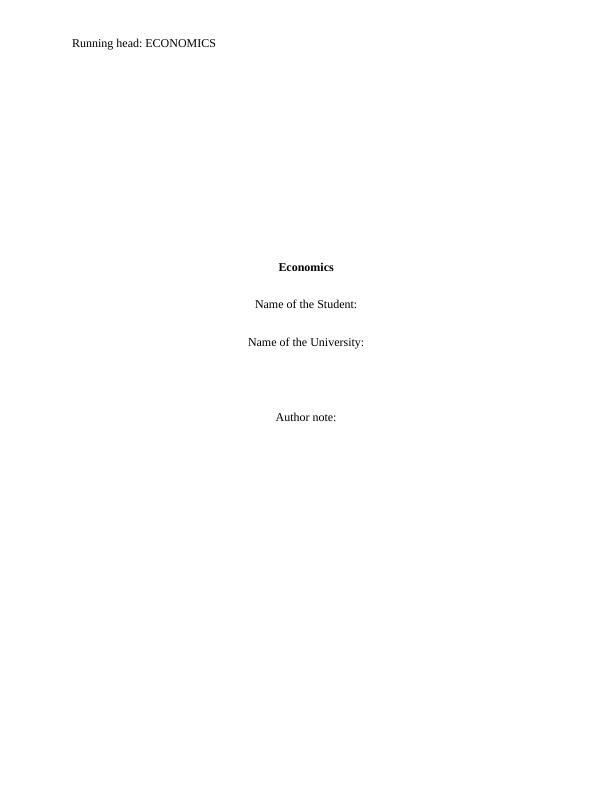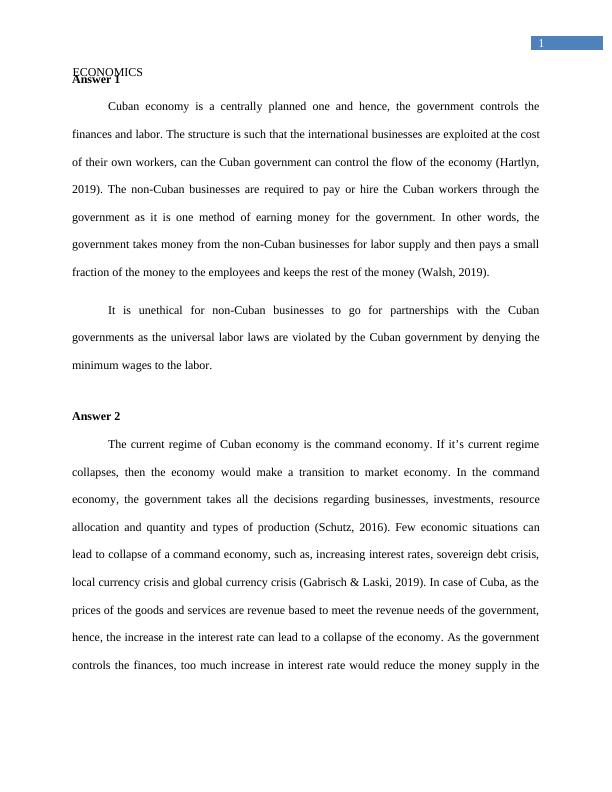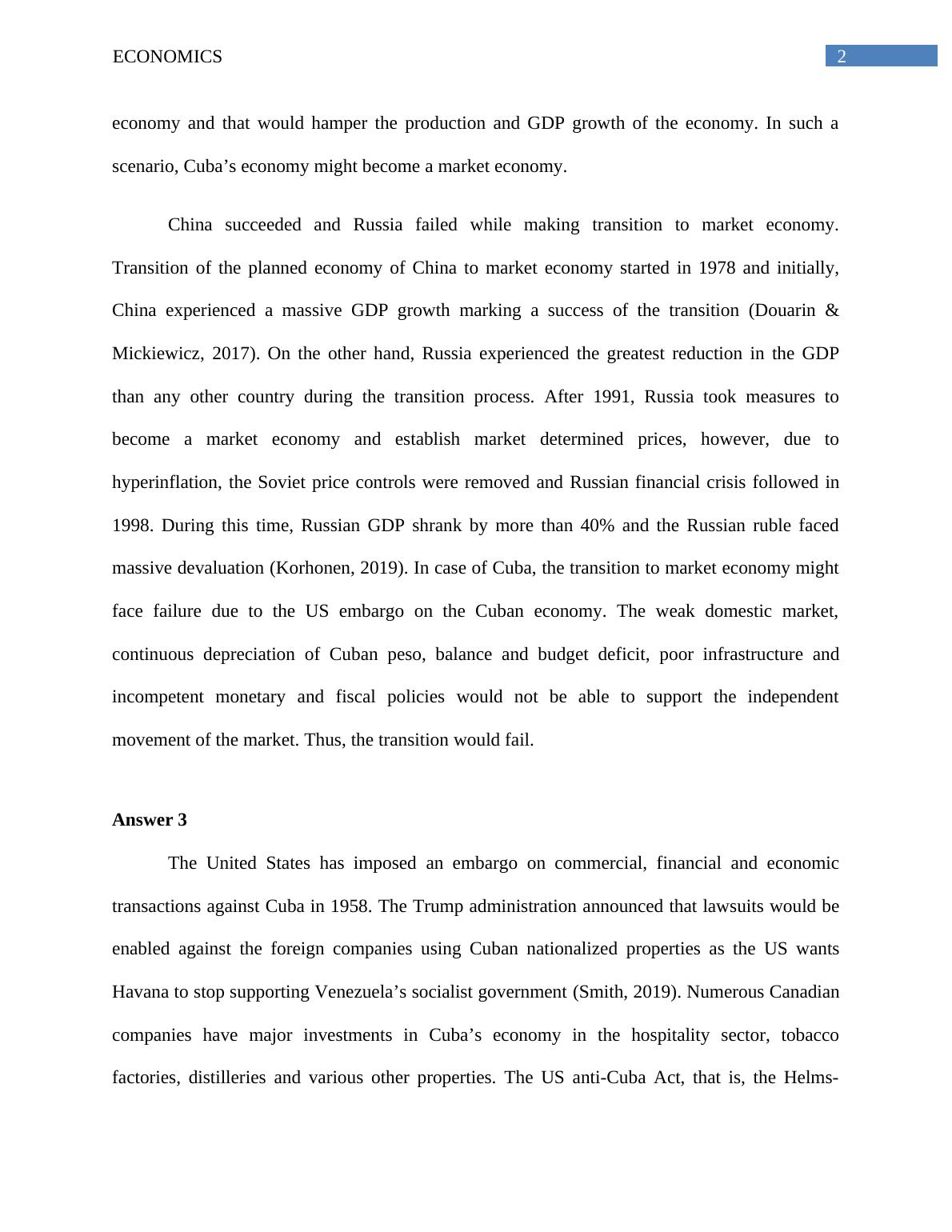Finances And Labor Under Government Controls
Added on 2022-08-16
6 Pages1167 Words15 Views
Running head: ECONOMICS
Economics
Name of the Student:
Name of the University:
Author note:
Economics
Name of the Student:
Name of the University:
Author note:

1
ECONOMICS
Answer 1
Cuban economy is a centrally planned one and hence, the government controls the
finances and labor. The structure is such that the international businesses are exploited at the cost
of their own workers, can the Cuban government can control the flow of the economy (Hartlyn,
2019). The non-Cuban businesses are required to pay or hire the Cuban workers through the
government as it is one method of earning money for the government. In other words, the
government takes money from the non-Cuban businesses for labor supply and then pays a small
fraction of the money to the employees and keeps the rest of the money (Walsh, 2019).
It is unethical for non-Cuban businesses to go for partnerships with the Cuban
governments as the universal labor laws are violated by the Cuban government by denying the
minimum wages to the labor.
Answer 2
The current regime of Cuban economy is the command economy. If it’s current regime
collapses, then the economy would make a transition to market economy. In the command
economy, the government takes all the decisions regarding businesses, investments, resource
allocation and quantity and types of production (Schutz, 2016). Few economic situations can
lead to collapse of a command economy, such as, increasing interest rates, sovereign debt crisis,
local currency crisis and global currency crisis (Gabrisch & Laski, 2019). In case of Cuba, as the
prices of the goods and services are revenue based to meet the revenue needs of the government,
hence, the increase in the interest rate can lead to a collapse of the economy. As the government
controls the finances, too much increase in interest rate would reduce the money supply in the
ECONOMICS
Answer 1
Cuban economy is a centrally planned one and hence, the government controls the
finances and labor. The structure is such that the international businesses are exploited at the cost
of their own workers, can the Cuban government can control the flow of the economy (Hartlyn,
2019). The non-Cuban businesses are required to pay or hire the Cuban workers through the
government as it is one method of earning money for the government. In other words, the
government takes money from the non-Cuban businesses for labor supply and then pays a small
fraction of the money to the employees and keeps the rest of the money (Walsh, 2019).
It is unethical for non-Cuban businesses to go for partnerships with the Cuban
governments as the universal labor laws are violated by the Cuban government by denying the
minimum wages to the labor.
Answer 2
The current regime of Cuban economy is the command economy. If it’s current regime
collapses, then the economy would make a transition to market economy. In the command
economy, the government takes all the decisions regarding businesses, investments, resource
allocation and quantity and types of production (Schutz, 2016). Few economic situations can
lead to collapse of a command economy, such as, increasing interest rates, sovereign debt crisis,
local currency crisis and global currency crisis (Gabrisch & Laski, 2019). In case of Cuba, as the
prices of the goods and services are revenue based to meet the revenue needs of the government,
hence, the increase in the interest rate can lead to a collapse of the economy. As the government
controls the finances, too much increase in interest rate would reduce the money supply in the

2
ECONOMICS
economy and that would hamper the production and GDP growth of the economy. In such a
scenario, Cuba’s economy might become a market economy.
China succeeded and Russia failed while making transition to market economy.
Transition of the planned economy of China to market economy started in 1978 and initially,
China experienced a massive GDP growth marking a success of the transition (Douarin &
Mickiewicz, 2017). On the other hand, Russia experienced the greatest reduction in the GDP
than any other country during the transition process. After 1991, Russia took measures to
become a market economy and establish market determined prices, however, due to
hyperinflation, the Soviet price controls were removed and Russian financial crisis followed in
1998. During this time, Russian GDP shrank by more than 40% and the Russian ruble faced
massive devaluation (Korhonen, 2019). In case of Cuba, the transition to market economy might
face failure due to the US embargo on the Cuban economy. The weak domestic market,
continuous depreciation of Cuban peso, balance and budget deficit, poor infrastructure and
incompetent monetary and fiscal policies would not be able to support the independent
movement of the market. Thus, the transition would fail.
Answer 3
The United States has imposed an embargo on commercial, financial and economic
transactions against Cuba in 1958. The Trump administration announced that lawsuits would be
enabled against the foreign companies using Cuban nationalized properties as the US wants
Havana to stop supporting Venezuela’s socialist government (Smith, 2019). Numerous Canadian
companies have major investments in Cuba’s economy in the hospitality sector, tobacco
factories, distilleries and various other properties. The US anti-Cuba Act, that is, the Helms-
ECONOMICS
economy and that would hamper the production and GDP growth of the economy. In such a
scenario, Cuba’s economy might become a market economy.
China succeeded and Russia failed while making transition to market economy.
Transition of the planned economy of China to market economy started in 1978 and initially,
China experienced a massive GDP growth marking a success of the transition (Douarin &
Mickiewicz, 2017). On the other hand, Russia experienced the greatest reduction in the GDP
than any other country during the transition process. After 1991, Russia took measures to
become a market economy and establish market determined prices, however, due to
hyperinflation, the Soviet price controls were removed and Russian financial crisis followed in
1998. During this time, Russian GDP shrank by more than 40% and the Russian ruble faced
massive devaluation (Korhonen, 2019). In case of Cuba, the transition to market economy might
face failure due to the US embargo on the Cuban economy. The weak domestic market,
continuous depreciation of Cuban peso, balance and budget deficit, poor infrastructure and
incompetent monetary and fiscal policies would not be able to support the independent
movement of the market. Thus, the transition would fail.
Answer 3
The United States has imposed an embargo on commercial, financial and economic
transactions against Cuba in 1958. The Trump administration announced that lawsuits would be
enabled against the foreign companies using Cuban nationalized properties as the US wants
Havana to stop supporting Venezuela’s socialist government (Smith, 2019). Numerous Canadian
companies have major investments in Cuba’s economy in the hospitality sector, tobacco
factories, distilleries and various other properties. The US anti-Cuba Act, that is, the Helms-

End of preview
Want to access all the pages? Upload your documents or become a member.
Related Documents
Economics Case Study Assignment | Keeping Brazil’s Economy Hotlg...
|4
|583
|294
Modeling the Determinants of Saudi GDP Growth Ratelg...
|10
|2237
|390
Impacts of US Monetary Policy Transition on Emerging Economieslg...
|14
|3820
|309
